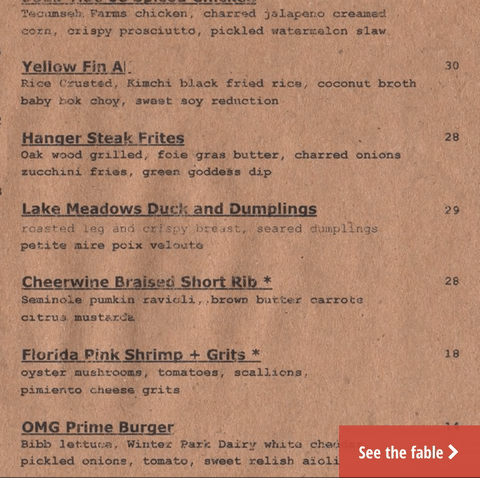Laura Reiley’s first investigation was a small one. But it proved to be a nibble into something much bigger, a story the Tampa Bay Times’ food critic took on this week.
Four years ago, over dinner at Tampa’s famous Bern’s Steak House, Reiley listened as the waiter expounded on specials that came from the restaurant’s eight-acre organic farm. She thought to herself: These things don’t grow in Florida this time of year. The following week, Reiley got into her car and drove to the farm. Nothing was growing — except grass. Her investigation ran in May 2012.
The farm is a field of grass and dirt and no vegetables are evident. Most of the restaurant’s produce comes from major food-service providers, and just a small portion of it is organic.
On Wednesday, Reiley’s latest work found the same was true at restaurants and farmers markets around the area. The series, “Farm to Fable,” takes Reiley and readers in search of government oversight, into restaurants to examine menus and chalkboards, into her car down rural roads seeking farms that don’t exist, to meet the frustrated farmers whose names are used but not their products, inside DNA labs to see what we’re really eating, and into farmers markets that often just sell tchotchkes and “Publix rejects.”
This is a story we are all being fed. A story about overalls, rich soil and John Deere tractors scattering broods of busy chickens. A story about healthy animals living happy lives, heirloom tomatoes hanging heavy and earnest artisans rolling wheels of cheese into aging caves nearby.
More often than not, those things are fairy tales. A long list of Tampa Bay restaurants are willing to capitalize on our hunger for the story.
“Farm to Fable” represents a new approach to investigative journalism from the Poynter-owned Tampa Bay Times. It’s written largely in first person. It relies more on illustrations than photojournalism. It was released all at once in a Netflix-like approach rather than over time. It’s the first big investigation for both Reiley and her editor. And it’s breaking Times’ traffic records.
Reiley has been surprised, so far, by the national response. But food is something everyone can relate to.
“It’s ironic, as we all know more about food and care more about food…the system itself has gotten really complicated in terms of food safety, food ethics, food waste,” she said. “There’s a lot to know, and I feel like in a way, the beat has expanded.”
Fifteen years ago, her work was rating what was on her plate. And she still does that. But now, she’s also asking — how did it get there?
The lean times
The shrinking of newsrooms has some obvious results — layoffs and furloughs, beats that hollow out and then disappear. Journalists are often pressured to “do more with less,” so it’s easy to miss that, sometimes, someone might be excited to do more.
That’s true for Reiley, who graduated from the California Culinary Academy with the intention of writing about food.
Since, she’s worked as a food critic for 25 years, from The Baltimore Sun to The San Francisco Chronicle to the Tampa Bay Times. At the Sun, she was one of two food critics. At the Chronicle, she was one of four. Those were fat times, Reiley says now. At the Times, she’s the only food critic and feels lucky to have a dedicated food editor. Her work is “like a very complicated kind of sudoku puzzle.” She has to cover high and low, all the price points, all the regions in the Times’ coverage area.
Part of that “all” includes Reiley’s expansion into covering Florida agriculture.
“As the industry contracts, we’ve all had to take a look at what we do and the reality that the job of a critic now is more than just to criticize,” said Stephanie Hayes, the Times’ arts and entertainment editor. “These are now full beats.”
“Farm to Fable” is the result of Reiley’s exploration into her growing beat, and it contains things she’d been hearing anecdotally for years. The series originally started with a look into what was really being sold at area farmers markets (mostly not food from area farms). As Reiley started making calls, she realized the story itself was a much bigger one, Hayes said.
“The thing that people are buying is the story,” she said. “They’re buying a feeling. They’re buying a mythology.”

A new recipe
Reiley started with a stack of menus. She sorted them into three piles: Claims that seemed sketchy, claims she’d like to check and claims that seemed legit. You can explore some of those menus yourself on the Times’ site and see if you can spot the false promises.
Both Hayes and Reiley were new to investigations when the reporting started in February. But Hayes thinks the story works because it doesn’t use a typical investigative approach. It’s not a data-driven investigation. It’s not a traditional narrative. It’s not a straight news story.
“It was sort of this space in between,” she said.
During the two months she worked on the project, Reiley didn’t write any reviews for the Times. As she and Hayes worked together, they considered using Reiley’s authority as a food critic with a first-person voice in the story. It was something new that they tried to apply artfully, Hayes said.
This also wasn’t the kind of story that would allow for deep, meaningful photojournalism. It was restaurants. It was plates of food. They had more leeway with farmers markets, public spaces where photojournalist Lara Cerri could shoot. They wanted to capture the visual sense of the story, and were able to do so with illustrations from the Times’ Steve Madden.
“This farm-to-table movement, this local food thing, the craft breweries, the exposed duct work, it’s just such a visual thing,” Hayes said.
They planned videos and even tried a few with a guerrilla approach, but they didn’t feel authentic, Hayes said. They also considered the best approach for publishing the series, which will begin in print on Sunday. Publish the first part and make people wait for the rest of the series, or give it to readers all at once? They decided to try something new and publish everything at one time.
Before the series began, the Times shared video teasers on Facebook, Twitter and Instagram, said Amber McDonald, the Times’ digital audience manager. They worked on the tweets and Facebook posts with Hayes and Reiley. And they worked on several headline options to make the most of social and SEO.
“Headlines are a small thing that make a huge difference for getting people to stop scrolling their newsfeed and click through to a story,” McDonald said. “Another important aspect to stopping the scroll is the social sharing image. We strategically vetted the images that get shared with the link on social as well.”
They were also careful not to make any one restaurant the face of the project, McDonald said.
“In addition to many variables, that was definitely something vital to our consideration.”
Together, they identified tweetable sharelines within the story, social language and the launch date and time.
The results:
- In the first 24 hours, “Farm to Fable” got about 150,000 pageviews
- Social media has driven 60 percent of the traffic.
- Launch day broke the previous Chartbeat record of 1,200 concurrent visitors on a single story, “landing at more than 1,800 people engaged with the restaurants story,” McDonald said. “Day two broke that record, with over 2,700 people on the restaurants story.”
Thanks to the instant social traction, McDonald said, “‘Farm to Fable’ is one of the fastest-growing projects the Tampa Bay Times has ever launched.”
More fish to fry
As a food critic, Reiley’s work is often an anonymous one, at least while sitting in the restaurants she reviews. But usually, when she picks up the phone and calls for interviews, her subjects are thrilled.
“I don’t have to push or prod or threaten or cajole or anything.”
For “Farm to Fable,” she had to call a lot of people over and over. And often, she called them back to challenge what they’d told her when she found it wasn’t true. Her biggest surprise — how quickly they folded.
“I was also surprised at how casual they were about it,” she said. “Almost like they didn’t recognize that it was a misrepresentation.”
Before the series came out, it already started causing some changes at farmers markets and restaurants, which updated menus and descriptions.
The kind of tenacity and toughness investigative reporting takes isn’t something she was ever taught to do. But she’s learned, since that first piece four years ago, about what it takes and what the pushback can be. She’s also learned that some of the skills necessary for investigative reporting can be taught, but some of it’s instinct.
“Maybe that’s something that gets refined the more frequently you get an investigation,” she said.
When Reiley wrote about Bern’s Steak House in 2012, she pissed off one of the area’s biggest restaurants. This time? She’s not so worried about the chefs she’ll need to call for those holiday food features.
Since her series published, she’s heard from chefs, farmers and journalists all over the country, but also in Tampa Bay. And a good number of them applauded her work. It was overdue, they told her. Reiley doesn’t plan to change her past reviews, some which focus on the farm-to-table experience at places she’s found are more like farm to warehouse to distributor to table.
“It makes me a little embarrassed and moving forward, I’m sure I’ll be a lot more skeptical of people’s claims,” she said.
While Reiley’s beat has expanded, food writers have always covered a range of topics, said Lee S. Dean, food editor at the Minneapolis Star Tribune for 24 years. But in the past, it took some convincing to get them in other parts of the newspaper.
“Today, however, with the great interest in anything food related, those stories appear throughout the newspaper, without writers and editors having to plead a case for them,” she said. “Those in charge today know that stories on food get high reader attention – and plenty of clicks online.”
The response to Reiley’s story has been encouraging for her team, Hayes said, and it’s shown them that arts and entertainment journalists can write important stories that matter to people.
“It’s an interesting story because it’s not dead babies or tainted water,” Reiley agreed, “but it’s something that people are passionate about.”







